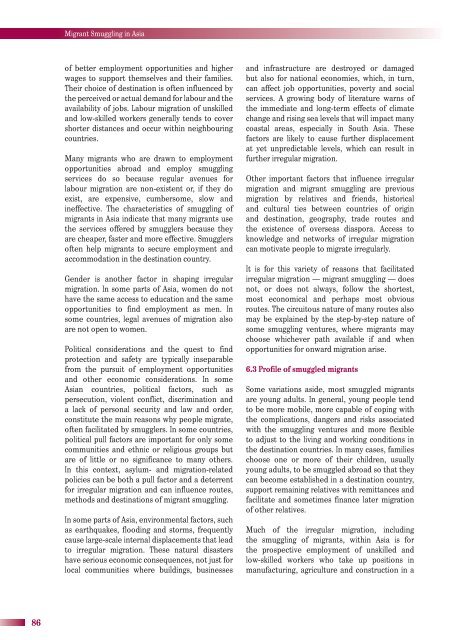Current_Trends_and_Related_Challenges_web
Current_Trends_and_Related_Challenges_web
Current_Trends_and_Related_Challenges_web
Create successful ePaper yourself
Turn your PDF publications into a flip-book with our unique Google optimized e-Paper software.
Migrant Smuggling in Asia<br />
of better employment opportunities <strong>and</strong> higher<br />
wages to support themselves <strong>and</strong> their families.<br />
Their choice of destination is often influenced by<br />
the perceived or actual dem<strong>and</strong> for labour <strong>and</strong> the<br />
availability of jobs. Labour migration of unskilled<br />
<strong>and</strong> low-skilled workers generally tends to cover<br />
shorter distances <strong>and</strong> occur within neighbouring<br />
countries.<br />
Many migrants who are drawn to employment<br />
opportunities abroad <strong>and</strong> employ smuggling<br />
services do so because regular avenues for<br />
labour migration are non-existent or, if they do<br />
exist, are expensive, cumbersome, slow <strong>and</strong><br />
ineffective. The characteristics of smuggling of<br />
migrants in Asia indicate that many migrants use<br />
the services offered by smugglers because they<br />
are cheaper, faster <strong>and</strong> more effective. Smugglers<br />
often help migrants to secure employment <strong>and</strong><br />
accommodation in the destination country.<br />
Gender is another factor in shaping irregular<br />
migration. In some parts of Asia, women do not<br />
have the same access to education <strong>and</strong> the same<br />
opportunities to find employment as men. In<br />
some countries, legal avenues of migration also<br />
are not open to women.<br />
Political considerations <strong>and</strong> the quest to find<br />
protection <strong>and</strong> safety are typically inseparable<br />
from the pursuit of employment opportunities<br />
<strong>and</strong> other economic considerations. In some<br />
Asian countries, political factors, such as<br />
persecution, violent conflict, discrimination <strong>and</strong><br />
a lack of personal security <strong>and</strong> law <strong>and</strong> order,<br />
constitute the main reasons why people migrate,<br />
often facilitated by smugglers. In some countries,<br />
political pull factors are important for only some<br />
communities <strong>and</strong> ethnic or religious groups but<br />
are of little or no significance to many others.<br />
In this context, asylum- <strong>and</strong> migration-related<br />
policies can be both a pull factor <strong>and</strong> a deterrent<br />
for irregular migration <strong>and</strong> can influence routes,<br />
methods <strong>and</strong> destinations of migrant smuggling.<br />
In some parts of Asia, environmental factors, such<br />
as earthquakes, flooding <strong>and</strong> storms, frequently<br />
cause large-scale internal displacements that lead<br />
to irregular migration. These natural disasters<br />
have serious economic consequences, not just for<br />
local communities where buildings, businesses<br />
<strong>and</strong> infrastructure are destroyed or damaged<br />
but also for national economies, which, in turn,<br />
can affect job opportunities, poverty <strong>and</strong> social<br />
services. A growing body of literature warns of<br />
the immediate <strong>and</strong> long-term effects of climate<br />
change <strong>and</strong> rising sea levels that will impact many<br />
coastal areas, especially in South Asia. These<br />
factors are likely to cause further displacement<br />
at yet unpredictable levels, which can result in<br />
further irregular migration.<br />
Other important factors that influence irregular<br />
migration <strong>and</strong> migrant smuggling are previous<br />
migration by relatives <strong>and</strong> friends, historical<br />
<strong>and</strong> cultural ties between countries of origin<br />
<strong>and</strong> destination, geography, trade routes <strong>and</strong><br />
the existence of overseas diaspora. Access to<br />
knowledge <strong>and</strong> networks of irregular migration<br />
can motivate people to migrate irregularly.<br />
It is for this variety of reasons that facilitated<br />
irregular migration — migrant smuggling — does<br />
not, or does not always, follow the shortest,<br />
most economical <strong>and</strong> perhaps most obvious<br />
routes. The circuitous nature of many routes also<br />
may be explained by the step-by-step nature of<br />
some smuggling ventures, where migrants may<br />
choose whichever path available if <strong>and</strong> when<br />
opportunities for onward migration arise.<br />
6.3 Profile of smuggled migrants<br />
Some variations aside, most smuggled migrants<br />
are young adults. In general, young people tend<br />
to be more mobile, more capable of coping with<br />
the complications, dangers <strong>and</strong> risks associated<br />
with the smuggling ventures <strong>and</strong> more flexible<br />
to adjust to the living <strong>and</strong> working conditions in<br />
the destination countries. In many cases, families<br />
choose one or more of their children, usually<br />
young adults, to be smuggled abroad so that they<br />
can become established in a destination country,<br />
support remaining relatives with remittances <strong>and</strong><br />
facilitate <strong>and</strong> sometimes finance later migration<br />
of other relatives.<br />
Much of the irregular migration, including<br />
the smuggling of migrants, within Asia is for<br />
the prospective employment of unskilled <strong>and</strong><br />
low-skilled workers who take up positions in<br />
manufacturing, agriculture <strong>and</strong> construction in a<br />
86


